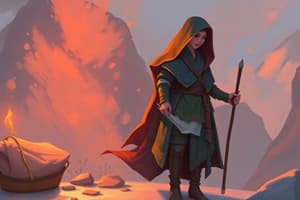Podcast
Questions and Answers
What time do students usually go to school?
What time do students usually go to school?
- At night
- In the evening
- In the morning (correct)
- In the afternoon
Children have dinner at night.
Children have dinner at night.
True (A)
When do children usually have lunch?
When do children usually have lunch?
In the afternoon
Children go to bed at _____
Children go to bed at _____
Match the following activities with their corresponding times:
Match the following activities with their corresponding times:
What do children do in the afternoon?
What do children do in the afternoon?
Breakfast is typically eaten in the evening.
Breakfast is typically eaten in the evening.
What do children play with?
What do children play with?
What activity does Lily mention she is going to do today?
What activity does Lily mention she is going to do today?
The students have tennis lessons in the afternoon.
The students have tennis lessons in the afternoon.
What do the students use to paint during their art lesson?
What do the students use to paint during their art lesson?
Lily and Fatma are excited about their art lesson because they get to paint __________.
Lily and Fatma are excited about their art lesson because they get to paint __________.
When do the students not have tennis lessons?
When do the students not have tennis lessons?
Atomic's color is described as blue and yellow.
Atomic's color is described as blue and yellow.
Match the following activities with their times:
Match the following activities with their times:
What happens when Polly is on the table?
What happens when Polly is on the table?
Which of the following is included in daily routines?
Which of the following is included in daily routines?
Children usually have breakfast after they wake up.
Children usually have breakfast after they wake up.
What do children do at school according to the content?
What do children do at school according to the content?
Children usually have __________ after school.
Children usually have __________ after school.
Match the activities with their respective times:
Match the activities with their respective times:
What is the first activity mentioned in the daily routines?
What is the first activity mentioned in the daily routines?
Polly is mentioned as playing during the day.
Polly is mentioned as playing during the day.
What color is Jack's bag?
What color is Jack's bag?
Flashcards are hidden until you start studying
Study Notes
Vocabulary and Daily Routines
- Key vocabulary includes terms related to daily activities: morning, afternoon, evening, night.
- Questions designed to encourage discussion about meal times and routines, such as asking when breakfast and dinner occur.
- Answers highlight typical daily schedules: breakfast in the morning, lunch in the afternoon, dinner in the evening, and bedtime at night.
Listening and Speaking Activities
- Activities focus on listening to questions about school routines and responding appropriately.
- Emphasis on using short phrases to describe when students engage in activities, such as attending school or playing sports.
- Includes interactive listening activities and games like "Snap" to reinforce vocabulary learning.
Reading and Comprehension
- Comprehension tasks involve reading questions and filling in responses based on the context presented.
- Encourages critical thinking by asking students to reflect on their routines compared to those illustrated in learning materials.
- Students asked to circle true/false statements based on a narrative for better comprehension.
Art and Creativity
- Activities such as drawing a colorful animal encourage creativity while reinforcing the day's lessons.
- Discussions around art help develop an appreciation for creativity and collaboration among peers.
Daily Routines and Comparisons
- Encourages students to think about their daily routine in relation to others, fostering comparison and dialogue.
- Activities include listening, discussing feelings about daily activities, and culminating in creative exercises or storytelling.
Thematic Integration
- Integrates values through storytelling, such as seeing beauty in everything and promoting a positive outlook on daily activities.
- The narrative encourages students to engage with the characters and scenarios to enhance emotional and social learning.
Studying That Suits You
Use AI to generate personalized quizzes and flashcards to suit your learning preferences.




